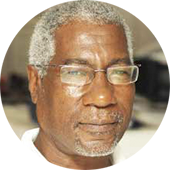
I woke-up on Independence Day glad my dog didn’t get its annual forever-fit from nearby fireworks the midnight before, but sad that 43 years after the Central Water Authority became the Water and Sewage Authority (WASA), I would wake-up without water in my pipeline and unable to bathe at home.
I bathed at a usual somewhere-else close-by with one bath for several users each with equal right of access – a place called “A Freeness” 43 years ago, but which today is a paid public facility, this one for seafarers like myself who ship to and from sea daily in very-much the same way they did long before 1979.
I bought a new bar of soap before entering my emergency bath, which, fortunately, is never without water – when open.
The plastic packaging indicated the soap was packaged at a factory in Shanghai, China — and is available here to any Saint Lucian: ‘Made in China’ and branded ‘Shanghai SulfurSoap’.
It’s label indicates it’s ‘Sterilization Composition’; and it’s produced as a ‘Shanghai Special Efficacy Skin Product’ through ‘new formulas of sulphur-sterilization’ to ‘kill bacteria an superficial fungal parasites’ and provide ‘skin disease adjuvant therapy”, especially ‘when you use it to wash the affected part’ by ‘keeping the soap suds for 3-5 minutes, then clean with water…’
The ingredients of the Shanghai SulfurSoap are: Sodium Aliphatate, Sulfur, Calcium Carbonate, Water, EDTA and Fragrance.’
The packaging also indicates all the normal information, from name and address of manufacturers to package numbers and dates of production and expiry.
It’s nothing like the artificially-enhanced smell of the regular brands (as anyone who knows the smell of sulphur will suspect or expect), but the Chinese producer neutralized the flatulent-like scent; and while it doesn’t smell like what my mom calls ‘Sweet soap’ or even ‘Blue soap’, it certainly smells like a soap-without-smell — and as frothy as all others.
But as I rubbed the bar over my body, I thought: ‘Why am I able to buy a bar of sulphur soap from China here, but not one from here?
I remember being able to buy locally-produced bare sulphur-soaps in plain plastic bags from Castries Market vendors for home use, but last time I asked (eons ago), the lady said it was “banned” – her supplier said “government banned people from collecting sulphur at Sulphur Springs, so she could no longer buy from her original source-supplier to make and sell soaps.
So, protection measures deemed necessary prevented enterprising locals from engaging in itinerant self-employment (producing Lucian Sulphur Soap), but I can easily buy Shanghai SulfurSoap here because the many millions of small Chinese entrepreneurs have the encouragement and assistance of the state to produce for commercial export.
But what about us?
We can’t and shouldn’t try to duplicate everything China is successful at, but we can and should learn from its valuable experiences in virtually everything.
We treat our Sulphur Springs only as a tourist attraction and a place locals can also pay to share what was created for visitors.
Formerly-open mud baths have been upgraded to concrete pool-type enclosures with better management of watchful use of the precious muddy resource — and no one can leave with even a matchbox of mud.
Similarly, the actual boiling springs are another tourism-oriented spectacle with trained guides reciting to every group of new visitors, foreign or local, now with upgraded information and assisted by technology, with movements more restricted than long ago when the likes of young me would freely venture to the boiling points to test “How long it would take for an egg to boil.”
Each time I end-up as a visitor to the Sulphur Springs, I wonder whether by my next visit the planners would have come-up with ideas for more careful and sustainable use of the natural resources we’ve got so accustomed to that we just take them for granted — as “The world’s only drive-in volcano”.
Robert Devaux points out in a booklet published by the Saint Lucia National Trust that the Sulphur Springs and The Pitons were part of an astronomical calendar system used by the indigenous people to measure time and distance.
I also learned from my veteran tour guide friend Carlton Ishmael that “a French King” who visited the island found “the sulphur spring water” so refreshing that he commissioned a study that resulted in discovery of the medical contents and he had ‘Mineral Baths’ constructed in Soufriere for his personal use, where visitors and local can also bathe today – for a fee.
And I grew-up with my paternal grandmother (from Soufriere) insisting (in the 1960s) that I had to get “a sulphur spring bath” that she also called ‘Bath of Life” and insisted it contained properties for both bodily and spiritual rejuvenation.
Between the baths, the mud and the forever-boiling outlets (at the Sulphur Springs), the astrological features of the Pitons used for measuring time by the region’s First People and the mineral baths, I always felt (and still do) there’s enough to start a new plan, based on a new vision, for an upgraded approach to elevate the related health-tourism aspects of first capital town to more than just places to see and take photographs.
Who’s researching the chemical and nutrient properties of our sulphur and mud, the temperature and chemical components of the water in the boiling pits, the effects of the water on the surrounding vegetation – and the actual healthy value of a ‘Sulphur’ or ‘Mineral’ bath?
Last time I visited Soufriere there wasn’t yet any talk about The Youth Economy.
But I’m sure that given what it’s intended to be, there must be young Saint Lucians who can come-up with innovative ideas to make Lucian Sulphur Soap smell sweet, find and document the therapeutic and medical nutrients of Sulphur Mud, tell what the Mineral Bath water is made of – and show today’s IT-minded citizens how our First People used Astronomy to tell time.












